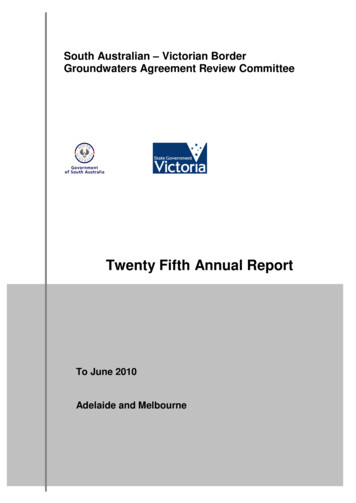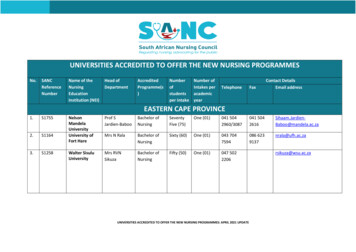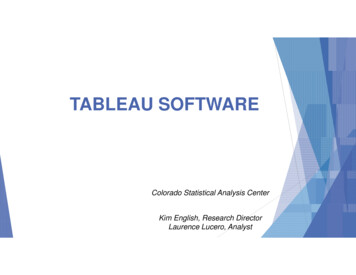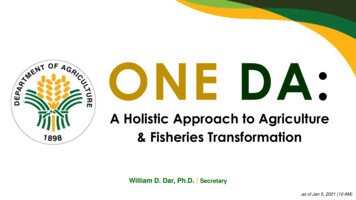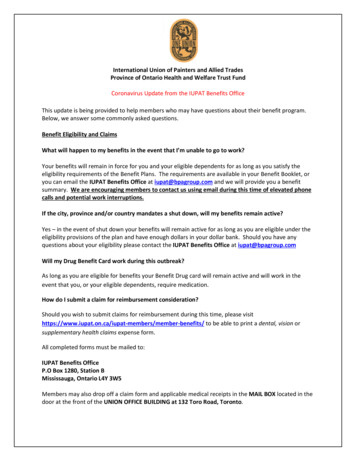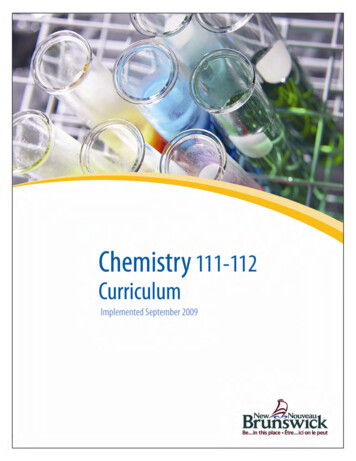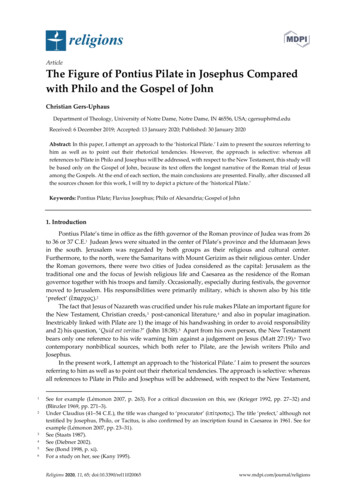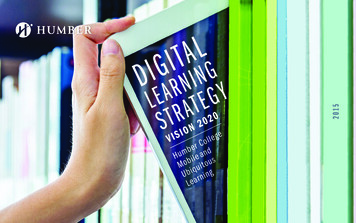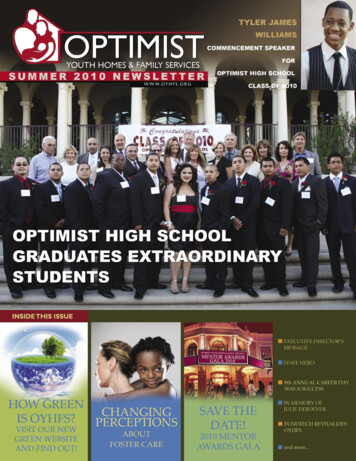
Transcription
Grade 12 ChemistryA Foundation forImplementation
GRADE 12 CHEMISTRYA Foundation for Implementation2013Manitoba Education
Manitoba Education Cataloguing in Publication DataGrade 12 chemistry [electronic resource] : a foundation forimplementationISBN: 978-0-7711-5285-61. Chemistry—Study and teaching (Secondary).2. Chemistry—Study and teaching (Secondary)—Manitoba.3. Chemistry—Curricula.530.0712Copyright 2013, the Government of Manitoba, represented by theMinister of Education.Manitoba EducationSchool Programs DivisionWinnipeg, Manitoba, CanadaEvery effort has been made to acknowledge original sources and tocomply with copyright law. If cases are identified where this has notbeen done, please notify Manitoba Education. Errors or omissions willbe corrected in a future edition. Sincere thanks to the authors,artists, and publishers who allowed their original material to be used.All images found in this document are copyright protected and shouldnot be extracted, accessed, or reproduced for any purpose other thanfor their intended educational use in this document.Any websites referenced in this document are subject to change.Educators are advised to preview and evaluate websites and onlineresources before recommending them for student use.Print copies of this resource can be purchased from the Manitoba TextBook Bureau (stock number 80534). Order online at www.mtbb.mb.ca .This resource is also available on the Manitoba Education website at www.edu.gov.mb.ca/k12/cur/science/scicurr.html .Disponible en français.Available in alternate formats upon request
Grade 12 Chemistry ckground 1Vision for Scientific Literacy 1Goals for Canadian Science Education 2Beliefs about Learning, Teaching, and Assessing ScienceChanging Emphases in Science 3Processes That Engage Students in Science Learning 52Section 1: Manitoba Foundations for Scientific Literacy1The Five Foundations 3The Nature of Science and Technology 4Science, Technology, Society, and the Environment (STSE) 6Scientific and Technological Skills and Attitudes 9Essential Science Knowledge 12The Unifying Concepts 13Kindergarten to Grade 10 Science andGrades 11 and 12 Chemistry Topic Chart 15Section 2: Implementation of Grade 12 Chemistry1The Senior Years Student and the Science Learning Environment 3Effective Teaching in Chemistry: What the Research Says to Teachers 14Unit Development in Chemistry 17A View of Chemistry Education: Toward Modes of Representation 18The Modes of Representation 18Toward an Instructional Philosophy in Chemistry 25Section 3: Assessment in Grade 12 ChemistryClassroom Assessment 3Changing Emphases in Assessment 4Purposes of Assessment 5Assessment Strategies 7Planning for Assessment 10Characteristics of Effective Assessment 10Managing Classroom Assessment 151Section 4: Document Organization1Document Organization and Format 3Guide to Reading the Learning Outcomes and the Document FormatSample Two-Page Layout 6General Learning Outcomes 8Cluster 0: Skills and Attitudes Outcomes 10Specific Learning Outcomes 133iii
Contents Grade 12 ChemistryGrade 12 ChemistryTopic 1: Reactions in Aqueous SolutionsTopic 2: Atomic Structure 1Topic 3: Chemical Kinetics 1Topic 4: Chemical Equilibrium 1Topic 5: Acids and Bases 1Topic 6: Electrochemistry 11Appendices 1topic 1 appendices 1Appendix 1.1A: Developing a Set of Solubility Rules: Lab Activity 3Appendix 1.1B: Developing a Set of Solubility Rules: Lab Activity(Teacher Notes) 4Appendix 1.2:Solubility Rules 7Appendix 1.3:Predicting Precipitation Reactions 8Appendix 1.4:Colour Chart for Ions in Aqueous Solutions 10Appendix 1.5:Identifying Unknown Solutions (Teacher Notes andPreparation Guide) 11Appendix 1.6A: Process Notes for Writing Net Ionic Equations(Teacher Notes) 13Appendix 1.6B: Process Notes for Writing Net Ionic Equations (BLM) 14Appendix 1.7A: Titration: Lab Activity 15Appendix 1.7B: Titration: Lab Activity (Teacher Notes) 18Appendix 1.8:Process Notes for Balancing Neutralization Reactions 20Appendix 1.9A: Test Tube Mystery: Lab Activity (Guidelines) 21Appendix 1.9B: Test Tube Mystery: Lab Activity (Preparation Guide) 23Appendix 1.9C: Test Tube Mystery: Lab Activity (Teacher Key 1) 25Appendix 1.9D: Test Tube Mystery: Lab Activity (Teacher Key 2) 26Appendix 1.10A: Compare and Contrast Oxidation and Reduction 28Appendix 1.10B: Compare and Contrast Oxidation and Reduction(Sample Response) 29Appendix 1.11: Oxidation Number Rules 30Appendix 1.12A: Practical Applications of Redox Reactions(Research Report and Presentation) 31Appendix 1.12B: Practical Applications of Redox Reactions(Sample Checklist and Assessment Rubric) 33topic 2 appendicesAppendix 2.1:Appendix 2.2:Appendix 2.3:Appendix 2.4:Appendix 2.5:Appendix 2.6:Appendix 2.7A:Appendix 2.7B:iv1Spectral Lines 3Gas Discharge Tubes (BLM) 5Flaming Salts (Demonstration) 6Observing Continuous Spectra and Line Spectra 8Blank Periodic Table of the Elements 9Table of Electronegativity Values 10Electronegativities (BLM) 11Electronegativities (Teacher Key) 12
Grade 12 Chemistry Contentstopic 3 appendicesAppendix 3.1:Appendix 3.2A:Appendix 3.2B:Appendix 3.3A:Appendix 3.3B:Appendix 3.4A:Appendix 3.4B:Appendix 3.5A:Appendix 3.5B:Appendix 3.6A:Appendix 3.6B:1Graphical Determination of Reaction Rate: Lab Activity 3Chemical Kinetics: Assignment 1 6Chemical Kinetics: Assignment 1 (Answer Key) 8Chemical Kinetics: Assignment 2 11Chemical Kinetics: Assignment 2 (Answer Key) 13Chemical Kinetics Problems 16Chemical Kinetics Problems (Answer Key) 18Factors Affecting the Rate of Reactions: Lab Activity 22Factors Affecting the Rate of Reactions: Lab Activity(Answer Key) 26Factors Affecting the Rate of a Reaction: Lab Activity 28Factors Affecting the Rate of a Reaction: Lab Activity(Teacher Notes) 31topic 4 appendices 1Appendix 4.1:Preparation of Equilibrium Systems (Demonstration) 3Appendix 4.2:Solving Equilibrium Problems Using the ICE TableMethod 5Appendix 4.3:Solving for Keq Using the BIR/PEC AccountingMethod 7Appendix 4.4:Equilibrium Problems 9Appendix 4.5:Chemical Equilibrium: Lab Activity 10Appendix 4.6A: An Analogy for an Equilibrium Reaction: Lab Activity 13Appendix 4.6B: An Analogy for an Equilibrium Reaction: Lab Activity(Teacher Notes) 15Appendix 4.6C: An Analogy for an Equilibrium Reaction: Lab ReportChecklist 16Appendix 4.7:Equilibrium and Le Châtelier’s Principle (Pre-lab) 17Appendix 4.8A: Qualitative Equilibrium: Lab Activity 18Appendix 4.8B: Qualitative Equilibrium: Lab Activity (Teacher Notes) 19Appendix 4.9:Disrupting Equilibrium Systems: Lab Activity 20Appendix 4.10: Interpreting Equilibrium Graphs 24Appendix 4.11: Interpreting Concentration versus Time Graphs 27v
Contents Grade 12 Chemistrytopic 5 appendicesAppendix 5.1:Appendix 5.2:Appendix 5.3A:Appendix 5.3B:Appendix 5.4:Appendix 5.5:Appendix 5.6:Appendix 5.7:Appendix 5.8:Appendix 5.9:1Selected Neutralization Indicators 3Acid-Base Indicators and pH: Lab Activity 4Measuring pH: Lab Activity 6Measuring pH: Lab Activity (Teacher Notes) 8Relative Strengths of Acids 9Quantitative Analysis: Acid-Base Titration:Lab Activity 10Analysis of Household Vinegar: Lab Activity 14Analysis of Aspirin: Lab Activity 16Potentiometric Analysis of Acid in Soft Drinks:Cola versus Non-cola: Lab Activity 18Samples of Various Titration Curves (Teacher Notes) 23topic 6 appendices 1Appendix 6.1:Activity Series: Lab Activity 3Appendix 6.2:Table of Standard Reduction Potentials 5General appendicesAppendix 7:Appendix 8:Appendix 9:Appendix 10:Appendix 11:Appendix 12:Bibliographyvi11Scientific Communication 3Research 11Assessment 17Developing Assessment Rubrics in Science 23Assessment Rubrics 29General and Specific Learning Outcomes 39
Grade 12 Chemistry AcknowledgementsACknowledgementsThis document is based on a draft version of Grade 12 Chemistry: A Foundation for Implementation,which was released on the Manitoba Education website in fall 2004. Manitoba Education gratefullyacknowledges the contributions of the following individuals in the development of the draft andfinal documents.Principal WritersMembers of theDevelopment TeamPost-secondary AdvisorGeorge D. BushConsulting Science EducatorWinnipeg, ManitobaElizabeth KozorizDaniel McIntyre CollegiateThe Winnipeg School DivisionMadeleine AsselinCollège Louis-RielDivision scolaire franco-manitobaineGeorge D. BushConsulting Science EducatorWinnipeg, ManitobaKelly Choy(until June 2005)Minnedosa CollegiateRolling River School DivisionKris Coulter(until June 2005)St. John’s High SchoolThe Winnipeg School DivisionLeona GrootGimli High SchoolEvergreen School DivisionJennifer KirkBalmoral Hall SchoolIndependent SchoolsKent LewarneNellie McClung CollegiatePrairie Spirit School DivisionAngela RussenholtJ. H. Bruns CollegiateLouis Riel School DivisionRick WiebeJohn Taylor CollegiateSt. James-Assiniboia School DivisionBrian LewthwaiteFaculty of EducationUniversity of Manitobavii
Acknowledgements Grade 12 ChemistryManitoba EducationSchool Programs Division StaffBureau de l’éducation françaiseDivision StaffviiiCarole BilykProject ManagerDevelopment UnitInstruction, Curriculum and Assessment BranchLouise BoissonneaultCoordinatorDocument Production Services UnitEducational Resources BranchSandra DrummondAdministrative AssistantDevelopment UnitInstruction, Curriculum and Assessment BranchDarryl GervaisDirectorInstruction, Curriculum and Assessment BranchLynn HarrisonDesktop PublisherDocument Production Services UnitEducational Resources BranchHeather Knight WellsScience Consultant(from August 2011 toFebruary 2012)Development UnitInstruction, Curriculum and Assessment BranchGabe KraljevicScience Consultant(from February 2012)Development UnitInstruction, Curriculum and Assessment BranchSusan LetkemannPublications EditorDocument Production Services UnitEducational Resources BranchJohn MurrayScience Consultant(until July 2011)Development UnitInstruction, Curriculum and Assessment BranchAileen NajduchScience Consultant(until June 2005)Instruction, Curriculum and Assessment BranchJacques DorgeDirector(until August 2011)Curriculum Development and ImplementationBranchDanièle Dubois-JacquesConsultantCurriculum Development and ImplementationBranchGilbert MichaudDirector(from September 2011)Curriculum Development and ImplementationBranch
Grade 12 ChemIstry IntroductionIntroductIonBackgroundGrade 12 Chemistry: A Foundation for Implementation presents student learningoutcomes for Grade 12 Chemistry. These learning outcomes are the same forstudents in the English, French Immersion, Français, and Senior Years TechnologyEducation Programs, and result from a partnership involving two divisions ofManitoba Education: School Programs Division and Bureau de l’éducation françaiseDivision.Student learning outcomes are concise descriptions of the knowledge and skills [andattitudes] that students are expected to learn in a course or grade in a subject area(Manitoba Education and Training, A Foundation for Excellence 14).Manitoba’s student learning outcomes for Grade 12 Chemistry are based, in part,on those found within the Common Framework of Science Learning Outcomes K to 12:Pan-Canadian Protocol for Collaboration on School Curriculum (Council of Ministers ofEducation, Canada) and on those developed as components of the 1998 ManitobaTransitional Curricula. The former, commonly referred to as the Pan-CanadianScience Framework, was initiated under the Pan-Canadian Protocol for Collaborationon School Curriculum (1995). It was developed by educators from Manitoba,Saskatchewan, Alberta, British Columbia, the Northwest Territories, the YukonTerritory, Ontario, and the Atlantic Provinces.Grade 12 Chemistry: A Foundation for Implementation provides the basis for learning,teaching, and assessing chemistry in Manitoba. This document also serves as astarting point for future development of curriculum support documents, relatedteacher support materials, learning resources, assessment tools, and professionallearning for teachers. This document also complements the Pan-Canadian ScienceFramework by providing support for its implementation, including suggestions forinstruction and assessment.Vision for Scientific LiteracyFactors such as global interdependence, rapid scientific and technologicalinnovation, the need for a sustainable environment, economy, and society, and thepervasiveness of science and technology in daily life reinforce the importance ofscientific literacy. Scientifically literate individuals can more effectively interpretinformation, solve problems, make informed decisions, accommodate change, andachieve new understandings. Science education makes possible the development ofthe foundations necessary to develop a functional scientific literacy and assists inbuilding stronger futures for Canada’s young people.Introduction – 1
Introduction Grade 12 ChemIstryThe Pan-Canadian Science Framework and Grade 12 Chemistry: A Foundation forImplementation support and promote an attainable and realistic vision for scientificliteracy.The [Pan-Canadian Science Framework] is guided by the vision that all Canadianstudents, regardless of gender or cultural background, will have an opportunity todevelop scientific literacy. Scientific literacy is an evolving combination of thescience-related attitudes, skills, and knowledge students need to develop inquiry,problem-solving, and decision-making abilities, to become lifelong learners, and tomaintain a sense of wonder about the world around them.Diverse learning experiences based on the [Pan-Canadian Science Framework] willprovide students with many opportunities to explore, analyze, evaluate, synthesize,appreciate, and understand the interrelationships among science, technology, society,and the environment that will affect their personal lives, their careers, and theirfuture (Council of Ministers of Education, Canada 4).Goals for Canadian Science EducationSeveral goals promoting the achievement of scientific literacy within Canadianscience education were developed as part of the Pan-Canadian Science Framework.These goals are addressed through the Manitoba science curricula. It is hoped thatscience education will encourage students at all levels to develop a rational sense of wonder andcuriosity about scientific and technological endeavours enable students to use science and technology to acquire new knowledge and tosolve problems, so they may improve the quality of their own lives and the livesof others prepare students to address science-related societal, economic, ethical, andenvironmental issues critically provide students with a proficiency in science that creates opportunities for themto pursue progressively higher levels of advanced study, prepares them forscience-related occupations, and engages them in science-related activitiesappropriate to their interests and abilities develop in students of varying aptitudes and interests a knowledge of the widevariety of careers related to science, technology, and support for the natural andhuman environmentsBeliefs about Learning, Teaching, and Assessing ScienceTo promote a rational, achievable approach to developing scientific literacy amongfuture citizens, it is crucial to recognize how students learn, how science can best betaught, and how learning can be assessed. Students are curious, active learners whohave individual interests, abilities, and needs. They come to school with priorknowledge and various personal and cultural experiences that generate a range ofattitudes and beliefs about science and life, and connections between these realms.2 – Introduction
Grade 12 ChemIstry IntroductionStudents learn most effectively when their study of science is rooted in concretelearning experiences related to a particular context or situation, and applied to theirworld of experiences, where appropriate. Ideas and understandings that studentsdevelop should be progressively extended and reconstructed as students grow intheir experiences and in their ability to conceptualize more deeply. Learninginvolves the process of linking newly constructed understandings with priorknowledge, and then adding new contexts and experiences to currentunderstandings. It is increasingly important that chemistry educators drawprofessional attention to how fundamental research in learning theory will affecttheir efforts in the science classroom.Changing Emphases in ScienceStudent learning outcomes in Grade 12 Chemistry encompass changing emphasesin science education content delivery and changing emphases to promote inquiry, asenvisioned in the National Science Education Standards (National Research Council113).Changing Emphases in Science Education Content DeliveryThe National Science Education Standards envision change throughout the system.The science content standards [or student learning outcomes] encompassthe following changes in emphases:Less Emphasis OnKnowing scientific facts and informationStudying subject matter disciplines(physical, life, Earth sciences) for theirown sakeSeparating science knowledge andscience processCovering many science topicsImplementing inquiry as a set ofprocessesMore Emphasis OnUnderstanding scientific concepts anddeveloping abilities of inquiryLearning subject matter disciplines in thecontext of inquiry, technology, science inpersonal and social perspectives, andhistory and nature of scienceIntegrating all aspects of science contentStudying a few fundamental scienceconceptsImplementing inquiry as instructionalstrategies, abilities, and ideas to belearnedChanging Emphases in Science Education Content Delivery: Reprinted with permission fromNational Science Education Standards. Copyright 1996 by the National Academy of Sciences,courtesy of the National Academies Press, Washington, DC.Introduction – 3
Introduction Grade 12 ChemIstryChanging Emphases to Promote InquiryThe National Science Education Standards envision change throughout the system.The science content standards [or student learning outcomes] encompassthe following changes in emphases:Less Emphasis OnMore Emphasis OnActivities that demonstrate and verifyscience contentActivities that investigate and analyzescience questionsInvestigations confined to one classperiodInvestigations over extended periods oftimeProcess skills out of contextProcess skills in contextIndividual process skills such asobservation or inferenceUsing multiple process skills—manipulation, cognitive, proceduralGetting an answerUsing evidence and strategies fordeveloping or revising an explanationScience as exploration and experimentScience as argument and explanationProviding answers to questions aboutscience contentCommunicating science explanationsIndividuals and groups of studentsanalyzing and synthesizing data withoutdefending a conclusionGroups of students often analyzing andsynthesizing data after defendingconclusionsDoing a few investigations in order toleave time to cover large amounts ofcontentDoing more investigations in order todevelop understanding, ability, values ofinquiry, and knowledge of sciencecontentConcluding inquiries with the result ofthe experimentApplying the results of experiments toscientific arguments and explanationsManagement of materials and equipmentManagement of ideas and informationPrivate communication of student ideasand conclusions to teacherPublic communication of student ideasand work to classmatesChanging Emphases to Promote Inquiry: Reprinted with permission from National ScienceEducation Standards. Copyright 1996 by the National Academy of Sciences, courtesy of theNational Academies Press, Washington, DC.4 – Introduction
Grade 12 ChemIstry IntroductionProcesses That Engage Students in Science LearningDevelopment of increased scientific literacy is supported by instructionalenvironments that engage students in the following: science inquiry: Students are encouraged to converse, ask penetrating questions,and then seek to explore their own constructed explanations alongside scientificexplanations through guided research, writing, and planned investigations. Problem solving: Students apply their acquired expertise and knowledge innovel, often unforeseeable, ways. decision making: As students identify rich, large-context problems, questions, orissues related to the human and robotic exploration of the universe around them,they pursue new knowledge that will assist them in making informed, rational,defensible decisions that are rooted in the societal and humanistic domainswithin which science practice operates. the nature of science: Students appreciate and value the understanding thatscience operates with the consent of personal, social, political, environmental,and multicultural orientations of the global society. Moreover, there areconsequences when science circumvents its responsibilities among these societalcontexts. science-related skills: Examples of science-related skills include initiating,planning, performing, recording, analyzing, interpreting, communicating, andteam building. All these skills have central importance in learning thedimensions of science. It is important that science students of today not be taughtthe myth of a single, specifiable “scientific method” that leads to a superior“truth” about the material world. If there is indeed an objective “reality,”philosophers of science often agree that it may be difficult to define, or perhapsmay be unknowable. Nevertheless, the methods of science systematically permitnew knowledge domains to be constructed, and that knowledge is often robustand durable. science content knowledge: Transmission of science content is no longerconsidered to be the primary outcome of science teaching. Science knowledge isactively constructed from existing and emerging personal and social knowledge.Creative, integrative, and interdisciplinary linkages should be balanced with thetraditional “disciplinary focus” of teaching and learning in chemistry. Unifyingconcepts among traditional, bounded, restricted disciplines now give way to, andadd form and substance to, new views of exploration among the sciences that areholistic and interdisciplinary.Through these processes, students discover the significance of science in their livesand come to appreciate the interrelatedness of science, technology, society, and theenvironment. Each of these processes can be a starting point for science learning,and may encompass the exploration of new ideas, the development of specificinvestigations, and the application of ideas that are learned.Introduction – 5
Introduction Grade 12 ChemIstryTo achieve the vision of a scientific literacy for all according to personal interestsand inclinations, students could become increasingly more engaged in the planning,development, and evaluation of their own learning experiences. They should haveopportunities to work cooperatively with other students, to initiate investigations,to communicate their findings, and to complete projects that demonstrate theirlearning in a personal, although peer-reviewed, manner.At the beginning of the instructional design process, teachers and students shouldidentify expected student learning outcomes and establish performance criteria. It isimportant that these criteria correspond with provincial learning outcomes. Thiscommunication between students and teachers helps identify clearly what needs tobe accomplished, thereby assisting in the learning process. (See Appendix 11 forrelated rubrics.)When students are aware of expected learning outcomes, they will be more focusedon their learning, and may be more likely to assess their own progress.Furthermore, they can participate in creating appropriate assessment andevaluation criteria. Assessment methods must be valid, reliable, and fair tostudents.6 – Introduction
Section 1:Manitoba FoundationS For ScientiFic LiteracyThe Five Foundations 3The Nature of Science and Technology 4Science, Technology, Society, and the Environment (STSE) 6Scientific and Technological Skills and Attitudes 9Essential Science Knowledge 12The Unifying Concepts 13Kindergarten to Grade 10 Science andGrades 11 and 12 Chemistry Topic Chart 15
Grade 12 ChemiStry Manitoba Foundations for Scientific LiteracyManitoba FoundationS For ScientiFic LiteracyThe Five FoundationsTo develop scientifically literate students, Manitoba science curricula are builtupon five foundations for scientific literacy that have been adapted from thePan-Canadian Science Framework to address the needs of Manitoba students: Nature of Science and Technology Science, Technology, Society, and the Environment (STSE) Scientific and Technological Skills and Attitudes Essential Science Knowledge Unifying ConceptsThe following conceptual organizer illustrates the five foundations for scientificliteracy representing the goals of science learning from Kindergarten to Grade 12 inManitoba.Manitoba Science Curriculum Conceptual , Technology,Society,and theEnvironmentdane, Constadsncy,anUnifyingiumibruilEqEnerConceptsThese foundations, which are described in more detail on the following pages, haveled to the development of the general learning outcomes identified for Grade 12Chemistry.Section 1 – 3
Manitoba Foundations for Scientific Literacy Grade 12 ChemiStryThe Nature of Science and TechnologyStudents learn that science and technology are creative human activities with longhistories in all cultures. Science is a way of learning about the universe. Thislearning stems from curiosity, creativity, imagination, intuition, exploration,observation, replication of experiments, interpretation of evidence, and debate overthat evidence and its interpretations. Scientific activity involves predicting,interpreting, and explaining natural and human-made phenomena. Manyhistorians, sociologists, and philosophers of science presently argue that there is nodefinable, set procedure for conducting a scientific investigation. Rather, they seescience as driven by a combination of theoretical concerns, knowledge,experiments, and processes anchored in the physical world.Producing science knowledge is an intrinsically collective endeavour. There is no suchthing as stand-alone science done in isolation. Scientists submit models and solutionsfor the assessment of their peers, who judge their logical, rational and experimentalsoundness through reference to the body of existing knowledge and modes ofrepresentation (Larochelle and Désautels 235).Scientific theories are being tested, modified, and refined continually as newknowledge and theories supersede existing knowledge bases. Scientific debate, bothon new observations and on hypotheses that challenge accepted knowledge,involves many participants with diverse backgrounds. This highly complexinterplay, which has occurred throughout history, is animated by theoreticaldiscussions; experimentation; social, cultural, economic, and political influences;personal biases; and the need for peer recognition and acceptance. Students willrealize that while some of our understandings about how the world works are dueto revolutionary scientific developments, many of our understandings result fromthe steady and gradual accumulation of knowledge. History demonstrates,however, that great advances in scientific thought have completely uprooted certaindisciplines, transplanting practitioners and theoreticians alike into an entirely newset of guiding assumptions. Such scientific revolutions, as discussed by Thomas S.Kuhn in his influential The Structure of Scientific Revolutions, constitute exemplarsthat can energize the science teaching enterprise—particularly in chemistryeducation.Technology results mainly from proposing solutions to problems arising fromhuman attempts to adapt to the external environment. Technology may be regardedas “a tool or machine; a process, system, environment, epistemology, and ethic; thesystematic application of knowledge, materials, tools, and skills to extend humancapabilities” (Manitoba Education and Training, Technology As a Foundation SkillArea 1). Technology refers to much more than the knowledge and skills related tocomputers and their applications. Technology is based on the knowledge ofconcepts and skills from other disciplines (including science), and is the applicationof this knowledge to meet an identified need or to solve a problem using materials,energy, and tools (including computers). Technology also has an influence onprocesses and systems, on society, and on the ways people think, perceive, anddefine their world.4 – Section 1
Grade 12 ChemiStry Manitoba Foundations for Scientific LiteracyGrade 12 Chemistry emphasizes both the distinctions and relationships betweenscience and technology. The following illustration shows how science andtechnology differ in purpose, procedure, and product, while at the same timerelating to each other.Science and Technology: Their Nature and Seeks answers toquestions that humans haveabout thenatural world)Applies ScientificInquiry Strategiessuch as hypothesizingand experimentingProposes Explanations forthe phenomena in thenatural worldNewQuestionsTechnology(Seeks solutions toproblems arising from humanattempts to adapt to theenvironment)Applies ProblemSolving Strategiessuch as designing,building, and testingProposes Solutionsto human problems ofadaptationSocial Applications and EnvironmentalImplications of Explanations and l Actions Based on Explanationsand Solutions* Source: Bybee, Rodger W., et al. Science and Technology Education for the Elementary Years: Frameworks for Curriculumand Instruction. Rowley, MA: The NETWORK, Inc., 1989. Adapted with permission.The following gene
Grade 12 Chemistry: A Foundation for Implementation provides the basis for learning, teaching, and assessing chemistry in Manitoba. This document also serves as a starting point for future development of curriculum support documents, related teacher support materials, learning resources, assessment tools, and professional learning for teachers.
